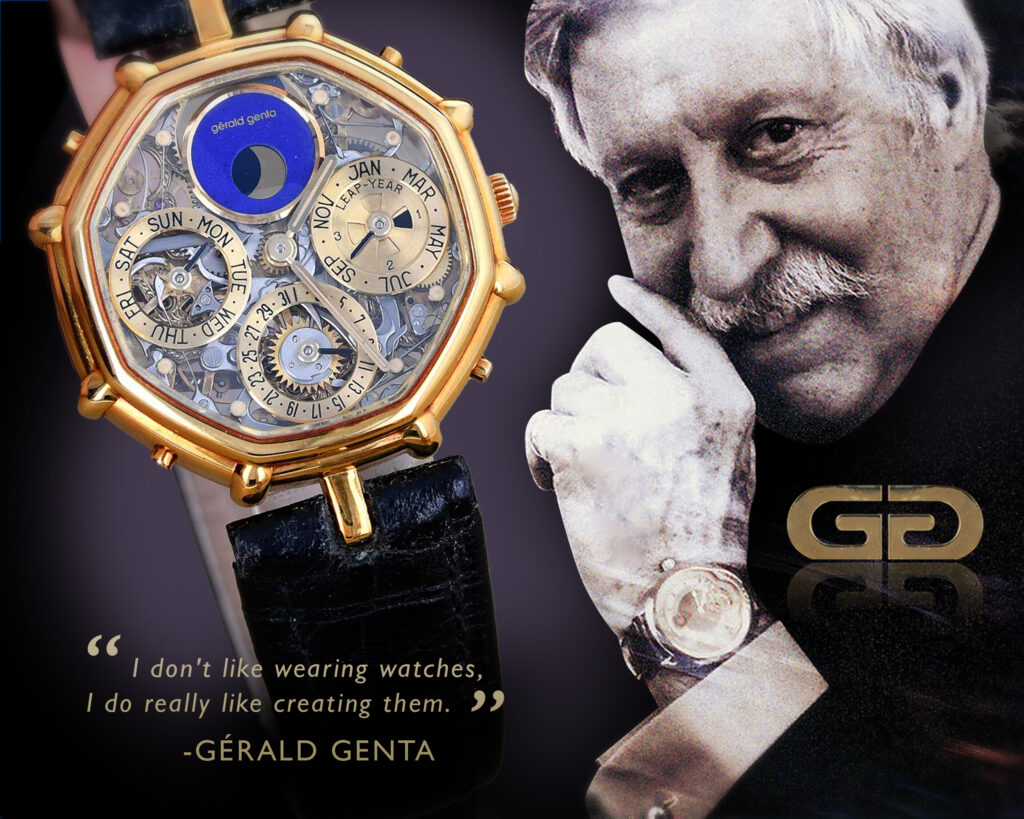Time’s Sculptor: Gérald Genta’s Artistic Mastery in Watch Design
By: Hung Cheuk Ying | Posted: December 20, 2023

In the world of watchmaking, few names resonate with as much reverence as Gérald Genta. This Swiss watch designer and horologist left an indelible mark on the industry, not by crafting movements but by defining the very essence of watch aesthetics. In this exploration, we journey through the life and innovations of Gérald Genta, the creative genius behind iconic watch case designs that continue to captivate enthusiasts and collectors worldwide. From the audacious birth of the Royal Oak to the elegance of the Nautilus, Genta’s legacy is not just a testament to his ingenuity but a timeless ode to the art of watch design.
Gérald Genta’s remarkable journey had its roots in humble beginnings. In his role as a budding watch designer, he embarked on a compelling odyssey across the Swiss watchmaking landscapes, spanning from La Chaux-de-Fonds to Le Brassus, where he tirelessly presented his meticulously crafted designs to various workshops. A distinctive tradition unfolded during these early days. As recalled by his wife, Evelyne, Genta would frequently knock on the doors of watchmakers, who would respond by opening a small hatch, through which he would pass a stack of his visionary designs. After that, the watchmakers would return with any designs they opted not to pursue while compensating Genta with 10 CHF for each design they chose to acquire. This process would repeat itself until Genta had amassed 1,000 CHF, at which point he would journey back home.
In 1954, at the tender age of 23, Gérald Genta unveiled his debut masterpiece – “The Polerouter.” It came in a 34.5mm case with bombé lugs and a dateless dial featuring a textured inner index ring. Thus, with a relatively slim case thickness of approximately 9mm.

© Fratello Watches
This exceptional timepiece was commissioned by Universal to honor a remarkable journey by Scandinavian Airlines Systems (SAS) from Copenhagen to Los Angeles via the Arctic. This pioneering route took them over the North Pole, where the Earth’s magnetic forces posed a significant challenge to timekeeping precision. SAS entrusted Universal Geneve with crafting a pilot’s watch tough enough to endure this magnetic disruption. Despite its slim design, it demonstrated remarkable resilience against the Earth’s magnetic influence.
Additionally, the initial few Polerouter models were bestowed upon the airline’s cabin crew as a tribute to their triumphant arrival at Los Angeles International Airport, hence, signifying Gérald Genta’s remarkable debut in the world of horology.
In the annals of watch design history, Gérald Genta’s journey reached a crescendo in 1969 when a pivotal call from Georges Golay, Audemars Piguet‘s Managing Director, initiated a momentous shift in watchmaking. Golay’s request was simple: create a groundbreaking steel sports watch overnight. Gérald Genta then embraced the challenge with unwavering determination.

© Revolution Watch
Over that fateful night, Genta drew inspiration from deep-sea diving helmets, particularly their conspicuously visible screws. By morning’s light, he had sketched a timepiece that would forever alter the horological landscape—the Royal Oak. This iconic watch featured an octagonal bezel adorned with 8 externally visible screws, a daring design move that defied industry norms of the time.
Unveiled at the 1972 Basel Fair, the Royal Oak initially raised eyebrows with its steel construction commanding a steep price tag of 3300 Swiss Francs. However, it didn’t take long for this unconventional masterpiece to captivate the industry, establishing itself as an icon and earning a place in the pantheon of horological legends. Years later, similar designs with externally visible screws can be found in Hublot‘s Big Bang series watches and all watches by Richard Mille, a testament to the enduring influence of Gérald Genta’s groundbreaking Royal Oak design.
In 1976, Philippe Stern of Patek Philippe commissioned Gérald Genta for a design journey that would result in the iconic Patek Philippe Nautilus. Inspired by ship portholes, Genta swiftly sketched the watch in just five minutes on a restaurant napkin. The Nautilus, with its soft-angled bezel and distinctive design, perfectly balanced sportiness and elegance. Initially, it featured only time and date functions, but over the years, it evolved into a flagship model with complications and precious materials. It’s now one of the world’s most coveted watches, with waitlists of up to a decade.

© European Watch Company
What sets the Nautilus apart is that it marked Patek Philippe’s entry into the sports watch category, a bold move for the traditionally conservative brand. While its resemblance to the Audemars Piguet Royal Oak initially raised eyebrows, the Nautilus succeeded in attracting a new audience of enthusiasts for elegant sports watches. Today, any early doubts about its originality have faded, and the Nautilus remains a timeless and stylish watch icon.
Gérald Genta’s creative universe extended well beyond watches, although he’s most renowned for his watchmaking accomplishments.
He once stated, “I don’t like wearing watches, I do really like creating them.” In addition to designing nearly a hundred thousand timepieces, Genta explored various design avenues, from crafting vases and cutlery to creating sunglasses and brand logos.

© 2 Tone Vintage
His fascination with the octagonal shape wasn’t confined to watchmaking but extended into his personal and professional life. The octagon was a recurring theme in his iconic watch designs, his wedding ring, and even his furniture. For Genta, the octagon wasn’t merely a geometric shape; it served as a canvas for hour indexes, symbolizing the seamless blend of artistry and precision. This octagonal obsession became a hallmark of his designs, transcending the boundaries of timekeeping.

© Loupe This
Genta’s personal anecdotes offer intriguing insights into his character. He championed traditional watch complications after the Quartz Crisis, reflecting his classical sensibilities. He also had a fondness for classical music and opera, although there was a unique exception in the 1990s when he immersed himself in Snoop Dogg and gangster rap for two weeks straight. While this influence didn’t directly impact his watch designs, it’s remarkable how quickly hip-hop culture embraced his iconic creations as symbols of status and style.

© Swiss Watches Magazine
Gérald Genta’s groundbreaking approach to watch design has left a lasting imprint on the industry, inspiring numerous prestigious brands. His signature elements, such as the integrated bracelet, bold aesthetics, and innovative use of materials, can be seen in various luxury timepieces. For instance, the Rolex Oyster Quartz echoes Genta’s seamless integration of the bracelet into the watch case. This influence extends beyond specific designs to inspire a broader philosophy of combining functionality with elegance in watchmaking. Genta’s legacy, therefore, not only reshaped the standards of luxury watch design but also sparked a wave of creative ingenuity across the horological world.

© IWC Schaffhausen
If you are inspired by the enduring legacy of Gérald Genta, connect with us at [email protected], or call (+63) 917 159 1211 for expert guidance in selecting a timepiece that embodies both history and style. Our specialists are here to assist you in discovering a watch that perfectly aligns with your taste. For a broader glimpse into our exquisite collection, visit our official website at www.vintagegrail.com.
Disclaimer: The views and opinions contained in this article belong solely to the individual author and do not reflect the views and opinions of the company. We are not affiliated, associated, authorized, endorsed by, or in any way officially connected with any of the brands mentioned, or any of its subsidiaries or its affiliates.






